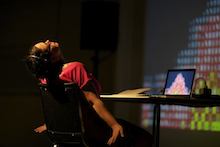|
Summary |
Tenebris in Lux |
|---|---|
|
Start Date |
Mar 7, 2014 5:30 pm |
|
End Date |
Mar 17, 2014 5:30 pm |
|
Venue |
Plimsoll Gallery, Centre for the Arts, Hunter Street, Hobart |
|
RSVP / Contact Information |
Open 12 noon – 5pm, six days per week – closed Tuesdays. |

Tenebris in Lux : The Performance of Code and the Aesthetics of Transmission in contemporary art through practice-orientated research.
Thesis Abstract:
This thesis contributes to the discourse on the role played by computational machines in contemporary culture, specifically, in contemporary art and performance. A position is developed that unmasks the creative possibilities of experiencing the computer as a theatre machine, a mechanism of infinite purposes and diverse desires, rather than solely as an unmediated presentation of a ‘ready-made’ functional tool. The research questions the current aesthetic emphasis on the ‘transparency’ of computational media, and examines the depth of the reach of the machine into the social fabric of everyday life through a series of experimental artworks and performances.
The research areas mobilised in the artworks and applied in the exegesis posit that the distinguishing character of computer networks and systems lies in their materiality and the modes of performance they enable, through which human beings participate and interact. An exploration of the black-box metaphor - as applied to both computers and theatre and a review of links they share - demonstrates how perceptions about techné and the aesthetic use of technology are shaped by a knowledge of social histories, politics and cultural experiences. Dramaturgy is a central discipline framing the project because performative actions offer an insight into, and elaboration of, aesthetic processes and the effect of technical provocations.
The terms ‘performance of code’ and the ‘aesthetics of transmission’ are developed and applied to examine thinkers and artists, including Valeska Gert, Bertolt Brecht, Pina Bausch, Maya Deren, Francis Yates, Richard Stallman, Jalal Toufic, Florian Cramer, Critical Engineers; Danja Vasiliev, Julian Oliver and !mediengruppe BITNIK. The transdisciplinary nature of their work pushes the boundaries of their specific genres, but as a group they are united by practices that are radical, embodied and connected. In most cases, they present a paradoxical combination of satire and transcendentalism.
The extent in which metaphysics and speculative thinking are present in contemporary computer culture is considered in depth through the artworks developed for the thesis, particularly with reference to performance. It is suggested that the depth of a practitioner’s historical knowledge affects how art is made; consequently, the emergence of new forms of expression, and the mixing of different mediums and technologies, will always lead to a re-examination of aesthetics and ethics. Specifically, this perspective was explored and developed through a field trip to Haiti, to collaborate with a community of artists who combine Vodou culture and sculpture.
The potentiality and limitations of contemporary art practices that engage with emergent technologies are outlined, and their field of action is analysed from a practitioner’s perspective. Beyond this technological pragmatism, the inquiry instead points to a richer engagement with technology that can occur through the application of arcane cultural practices from speculative traditions of thinking that include cryptography, theatre and occult philosophy.
Underlying the artworks that make up this thesis is a methodology for defining a radical subjectivity. By drawing attention to the apparatus used to construct and enact the work, new models of aesthetic engagement are created which can be characterised by a playful enactment (a ludibrium) of arcane or cryptic tropes rather than illustration or representation. The thesis concludes that profound play with the limits of a given schema, even of the most utilitarian kind, can lead to startling transfigurations and unanticipated ripples of sway far beyond the maker’s intent.
Nancy Mauro-Flude 2014
